Construction scheduling has always demanded meticulous attention to detail and precise planning. Traditionally reliant on manual labor, the construction industry is now embracing technological innovations, particularly data analytics, to enhance planning and execution processes. This shift promises more reliable schedules, cost control, and efficient resource management.
The Role of Data Analytics in Modern Construction
Enhancing Project Visualization with 4D Simulations
Data analytics coupled with construction scheduling enables the creation of 4D simulations, which are instrumental for project visualization. These simulations incorporate time as the fourth dimension along with the traditional three dimensions of space. By animating how construction projects will unfold over time, stakeholders gain a clearer understanding of various phases. This capability allows detailed assessments of project milestones, impacts on costs, and resource allocation. The ability to visualize these aspects in such an intricate manner ensures that any potential discrepancies are identified and addressed early in the planning phase.
4D simulations help prevent unforeseen issues by illustrating potential conflicts or inefficiencies before they arise on-site. Furthermore, these visualizations assist in aligning all involved parties, from architects and engineers to contractors and clients, ensuring everyone shares a common perspective on project progression. The value of such precise visualization extends beyond planning to real-time monitoring, offering updated views as the project progresses. This not only enhances communication among different stakeholders but also fosters a more cohesive and collaborative approach to project management.
Real-Time Data Dashboards for Project Control
Data analytics tools furnish construction managers with advanced dashboards that consolidate real-time data. These dashboards are pivotal in tracking time, cost, and resource utilization metrics, offering a comprehensive view of project health. By integrating various data streams into a unified interface, managers can quickly identify deviations from plans, allowing for timely interventions. This real-time monitoring capability significantly reduces the likelihood of mistakes and helps maintain project timelines and budgets.
These dashboards enhance decision-making by providing insights and forecasts based on current data. This way, construction sites adopt a proactive approach rather than responding reactively to issues. Real-time dashboards thus transform project oversight from a complex, fragmented task into a coherent, streamlined process. Managers can make informed decisions quickly, mitigating potential risks and ensuring that projects stay on track. The ability to visualize all critical metrics in one place also encourages a more systematic and organized approach to project management.
Predictive Analysis: Foreseeing Delays and Bottlenecks
Identifying Potential Hurdles in Advance
One significant advantage of data analytics in construction is the development of predictive analysis tools. By examining historical and current project data, these tools detect patterns and anomalies, suggesting potential delays and efficiency pitfalls before they materialize. Such foresight is crucial for managers who aim to preemptively address challenges, reducing the risk of project setbacks. Identifying these issues in advance allows for the implementation of corrective measures that can prevent minor difficulties from escalating into major obstacles.
Predictive analysis not only highlights immediate concerns but also contributes to long-term planning. By understanding common issues in past projects, managers can craft more robust schedules and plans for future endeavors. This forward-looking approach ensures a higher degree of reliability and efficiency in project scheduling. Additionally, early identification of potential problems can result in significant cost savings and more efficient resource utilization, ultimately leading to more successful project outcomes.
Improving Performance Forecasting
Predictive models are invaluable for performance forecasting. Managers can simulate different scenarios based on data inputs, aiding in the creation of schedules that are both realistic and optimized for available resources. These scenarios inform decisions on everything from timeline adjustments to resource reallocation, ensuring plans are both feasible and efficient. This capability allows project managers to anticipate and plan for potential obstacles, rather than merely reacting to them as they arise.
Employing predictive analytics tools, construction firms can significantly reduce uncertainty, improve timelines, and avoid budget overruns. The ability to anticipate and plan for issues translates to smoother project execution and greater client satisfaction. This proactive approach not only enhances the likelihood of meeting project deadlines but also contributes to a more organized and controlled project environment, which can significantly improve overall project quality and satisfaction levels among stakeholders.
Optimizing Resource and Equipment Allocation
Ensuring Efficient Resource Use
Efficient management of resources and equipment is a critical component of successful construction projects. Data analytics allows for real-time predictions regarding resource usage, performance, and maintenance costs. By accessing this data, construction firms can allocate machinery and labor optimally, ensuring that resources are neither underutilized nor overstretched. This optimal allocation helps in maintaining a balanced use of resources, preventing any unnecessary wear and tear on equipment and avoiding project delays caused by resource shortages.
Real-time data further aids in avoiding unexpected downtimes due to equipment failure or other issues. Proactive resource management supported by analytics guarantees that projects progress without undue interruptions, maintaining both time and budget constraints. This continuous monitoring and adjustment of resource allocation help in maximizing efficiency, ensuring that every part of the project runs as smoothly as possible. Additionally, timely maintenance and proper utilization of resources contribute to extending their lifespan and reducing overall project costs.
Enhancing Operational Efficiency
The construction industry has always required close attention to planning and detail, crucial tasks typically handled through manual processes. However, with the advancement of technology, the industry is shifting towards the use of data analytics to significantly improve these planning and execution processes. Data analytics systems can offer more reliable project schedules, better cost control, and more efficient management of resources, making construction projects more predictable and controlled.
Construction scheduling, which has always been a meticulous endeavor, benefits immensely from these technological advancements. Traditional methods relied heavily on manual labor, which could be error-prone and time-consuming. Introducing data analytics transforms this landscape, allowing for more accurate forecasting, efficient allocation of materials and labor, and timely project completion.
Embracing technological innovations in construction not only enhances the reliability of schedules but also helps in keeping costs in check and resources optimally managed. This evolution marks a significant shift from manual to digital processes, promising greater efficiency and precision in future construction projects.









